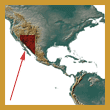 |
| approximate
range |
|
|
|
|
|
|
Original
Description |
Cooper 1863 : 120 |
|
Type
Locality |
"mountains of California, near Fort Mojave" [USA]; surviving syntype (USNM) from "Utah Basin, Mojave River" (USNM catalog reads 'Soldado Valley, California') according to Cochran (1961:236) |
|
Syntypes |
"Three young specimens, a male of seven years of age, two females of six and four years . . ", apparently originally in the California State Geological Survey collection according to Cooper (1863:120). Syntypes apparently transferred to other collections, since USNM 7888 was listed by Cochran 1961:236 as one of the syntypes; if the other syntypes were transferred to the CAS collection in San Francisco, they were destroyed in the 1906 earthquake and fire. |
|
Original name |
Xerobates agassizii |
|
Common
name |
Desert Tortoise |
|
Distribution |
Southeastern California, southern Nevada, and southwestern Utah through southern Arizona (USA), Sonora to northern Sinaloa, and (possibly introduced) the cape region of Baja California Sur, Mexico) |
|
Comments |
Reviewed by Auffenberg and Franz (1978a and b), Smith and Smith (1979), Groombridge (1982), and Berry (in Swingland and Klemens, 1989). Xerobates lepidocephalus, described by Ottley and Velázquez-Solis (1989:497) from the Cape region of Baja California Sur, is apparently synonymous with G. agassizii (Crumly and Grismer, 1990; see also Pritchard, 1990). |
|